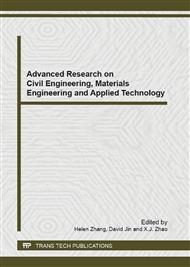p.91
p.95
p.100
p.105
p.109
p.114
p.122
p.127
p.131
Interface Structure of EPS and Pores Effect on Properties of EPS Lightweight Concrete
Abstract:
The weak interfacial bond strength EPS beads and large intercommunicating pores in the EPS lightweight concrete result in degradation of the mechanical properties of the concrete. The interface bond properties between EPS beads and the concrete can be improved by using the polyvinyl acetate (PVA) emulsion and silica fume. To prevent EPS beads rise up to the surface in the concrete mixing and reduce the number of larger pores in the concrete, vibrating with pressure, which can enhance the mechanical properties of the concrete, is applied. To decrease the aperture size of large pores and enhance thermal performance of the concrete, it is appropriate to decrease EPS beads size . The three-dimensional net structure formed by the polyvinyl acetate (PVA) emulsion and the hydration products of cement in the large pores of the concrete can reduce connectivity of the pores in the concrete ,thus the anti-frozen properties of the concrete is up as well.
Info:
Periodical:
Pages:
109-113
Citation:
Online since:
December 2013
Authors:
Price:
Сopyright:
© 2014 Trans Tech Publications Ltd. All Rights Reserved
Share:
Citation:


